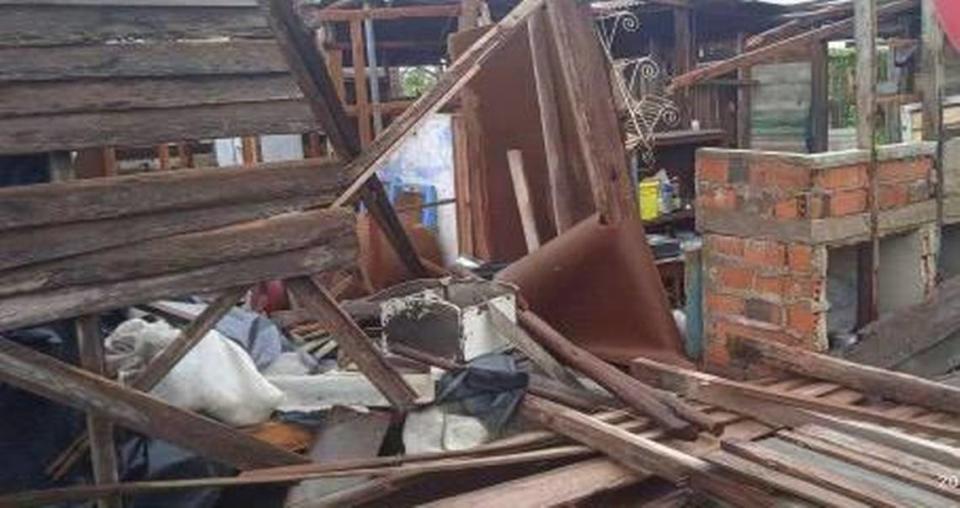‘They were left with nothing’: Cubans in Pinar del Río face uncertain recovery after Hurricane Ian
Some of the towns that took the brunt of Hurricane Ian’s hit on Cuba’s westernmost province of Pinar del Río are without electricity, phone service, food or water, and their residents are roaming the streets uncertain about how they will recover from a disaster that has left many without a roof over their heads.
Residents in La Coloma, a small town in Pinar del Río that was in the path of the Category 3 storm at landfall, lived hours of terror as the storm surge flooded their homes and the winds struck down the flimsy zinc roofing on many of its fragile homes.
At 6 a.m. Tuesday, Carmen Pino, a former Cuban independent journalist and dissident who now lives in Tampa, received a terrifying call.
“It was my sister, and then I saw my father in waist-deep water,” sitting in a rocking chair in his living room, she said. “That image will forever stay with me for the rest of my life.”

The harrowing video of her 99-old father, Jesús María Pino Alemán, that she published on Facebook quickly went viral and became a stark reminder of the vulnerability of a population riding out a major hurricane with little preparation and few resources.
The hurricane that barreled through western Cuba with strong winds, torrential rains and storm surges laid bare the fragility of Cuba’s infrastructure and housing. Millions have been without electricity for two days and counting after the country’s entire electrical grid collapsed. Authorities said it would take time to restore service to the population of 11 million. The storm left at least three dead, and 5,000 residents from Pinar del Río and Mayabeque provinces remain in government shelters because they cannot return to their homes — if they still have one.
As many as 50 percent of the homes in the coastal town of Cortés, in the municipality of Sandino, suffered “considerable damage,” local television channel Tele Pinar said. In San Luis, another municipality, about 4,000 homes were damaged.
Cubans living in South Florida who have heard from family in Pinar del Río are increasingly concerned about their relatives’ plight.
“My aunt and cousin lost their wooden houses in Buenavista,” in San Luis, Cuban actress Gelliset Valdés told el Nuevo Herald. She has not been able to speak to them but learned the news through her brother. Buenavista is a tobacco town in a rural area.
“They are without electricity and internet connection. My whole family is there; I was born and lived there until I was 16 years old,” said the actress, who arrived in Miami in December. She worries that several of her relatives have been left homeless.
“Pinar del Río was left with nothing; the city is destroyed,” said Margarita Casas of Miami, who was finally able to communicate with her husband, who was visiting relatives in the city of Pinar del Río, when the storm reached Cuba.
“All the tile roofs of the colonial houses are on the ground. My dad, who is 80 years old, says that this is the worst hurricane he has ever seen,” she said.
“They were already going through a lot to get food, and there were days when they had electricity for only four hours. I don’t know when they will be able to recover from this,” she added. She hopes her husband can fly back on Friday.
Hospitals, schools, highways, baseball stadiums and factories all bear the marks of Ian’s destructive path over Pinar del Río. “The city and surrounding highways are devastated,” said Roberto Padrón Carmona, an employee at the local radio station Radio Guamá. Half of the province’s Soviet-style school buildings lost windows or suffered other damages.
As many as 220 tons of tobacco are spoiled, and the sheds used to cure tobacco are gone. “There are none standing,” said Marino Murillo, the head of Cuba’s leading tobacco distribution company Tabacuba, according to TelePinar.
As Ian was moving away from the island, Cuban government officials started holding meetings to discuss a response. Some, including the country’s handpicked president, Miguel Díaz-Canel, toured some places to assess the damages. But there’s little public information on how the promised aid is reaching the most vulnerable communities.
According to Pino, residents in La Coloma are among those lacking government assistance. She said she lost direct communication with her family, but she is in touch with other residents. Videos they sent to her that she shared with the Herald show the devastation the hurricane left and the lack of government response in its aftermath.
“People complain because no one has come here to see whether we are dead or alive,” said a resident of La Coloma in one of the videos shared with the Herald. In another video, a woman shows the damage along one of the town’s main streets, with no first responders or government officials in sight.
“Right now, one of the things that worries me the most is that my father does not have medical assistance,” Pino said. She said he lost his medication during the flooding, along with most of the food she had been sending from the United States. She also said local authorities have only provided food to the small number of people that took shelter in the town’s school, the medical clinic and the kindergarten center.
“It is inconceivable that they take food to a town that is in a state of desperation, and they give it only to some people when they know that most of that population lost everything,” Pino said. “The government is being cruel in the same way that the sea was with my people.”

 Yahoo Movies
Yahoo Movies 
